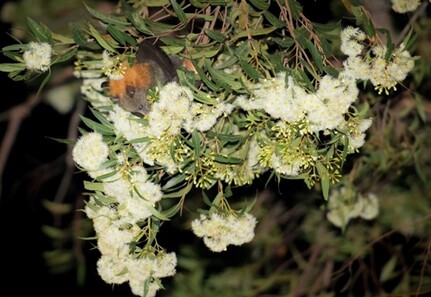Sienna Grady
- PhD Student, Lab of Animal Ecology, Hawkesbury Institute for the Environment, Western Sydney University.
- Topic: Monitoring the spatiotemporal dynamics of nectar availability for the grey-headed flying-fox across eastern Australia
- Research Umbrella: Flying-fox movement ecology; Flying-fox conservation management
- Supervisors: Prof Justin Welbergen, Dr Jessica Meade, Prof Matthias Boer
- Contact: Sienna Grady
Bio:
I completed a Bachelor of Science (Zoology) at Western Sydney University in 2019. Afterwards, I participated in several volunteer programs of bush regeneration until I volunteered for the Lab of Animal Ecology in studying the vocal mimicry of the female Superb Lyrebird in the Blue Mountains. This reinforced my interest in wildlife research, leading me to go back and do a Master of Research at Western Sydney University with the Lab of Animal Ecology in mid-2020.
I completed my Master of Research on the impacts of the 2019/20 megafires on the grey-headed flying-fox (Pteropus poliocephalus) in 2022, and began my PhD project on mapping eucalypt flowering to monitor the dynamics of nectar availability for the nectarivorous grey-headed flying-fox in September 2023. I am interested in the field of spatial ecology, remote sensing, and all things wildlife conservation.
I completed a Bachelor of Science (Zoology) at Western Sydney University in 2019. Afterwards, I participated in several volunteer programs of bush regeneration until I volunteered for the Lab of Animal Ecology in studying the vocal mimicry of the female Superb Lyrebird in the Blue Mountains. This reinforced my interest in wildlife research, leading me to go back and do a Master of Research at Western Sydney University with the Lab of Animal Ecology in mid-2020.
I completed my Master of Research on the impacts of the 2019/20 megafires on the grey-headed flying-fox (Pteropus poliocephalus) in 2022, and began my PhD project on mapping eucalypt flowering to monitor the dynamics of nectar availability for the nectarivorous grey-headed flying-fox in September 2023. I am interested in the field of spatial ecology, remote sensing, and all things wildlife conservation.

Research:
Quantifying nectar availability for nectarivores across multiple spatial and temporal scales is particularly challenging in Australia due to the inherent variability of flowering patterns in eucalypts (Myrtaceae); this variability is increasing as a result of anthropogenic climate change and land use changes, exemplified by the 2019/20 megafires in which 5.7 million hectares of eucalypt-dominated forests were burnt. Nectarivore population declines have been reported in association with overall reductions in nectar availability, and such declines are now a major conservation management issue in Australia. Monitoring the spatiotemporal dynamics of nectar availability across various spatial and temporal scales is key for identifying where and when resource gaps occur in the landscape and for providing spatially explicit targets for habitat restoration. This will enhance nectarivores' capacity to endure seasonal resource shortages and preserve their pollination services that underpin the persistence of both natural and managed ecosystems.
The grey-headed flying-fox (Pteropus poliocephalus) is a highly mobile nectarivore that is known to undertake regular movements at local to subcontinental scales in response to the phenological variation in flowering eucalypts. As a result of its extreme mobility, the grey-headed flying-fox provides crucial long-distance pollination (and seed dispersal) services that are vital for the maintenance and regeneration of forested ecosystems. However, the grey-headed flying-fox is listed as Vulnerable at the national and international level. Monitoring nectar availability across a full range of spatial and temporal scales is a much-needed step towards the adaptive management and conservation of this ecologically important but threatened species.
The overarching aim of this research is to generate large-scale historical and contemporary maps and forecasts of the flowering phenology of eucalypts, the primary forage plants for the grey-headed flying-fox. To achieve this, the specific research objectives are to:
Quantifying nectar availability for nectarivores across multiple spatial and temporal scales is particularly challenging in Australia due to the inherent variability of flowering patterns in eucalypts (Myrtaceae); this variability is increasing as a result of anthropogenic climate change and land use changes, exemplified by the 2019/20 megafires in which 5.7 million hectares of eucalypt-dominated forests were burnt. Nectarivore population declines have been reported in association with overall reductions in nectar availability, and such declines are now a major conservation management issue in Australia. Monitoring the spatiotemporal dynamics of nectar availability across various spatial and temporal scales is key for identifying where and when resource gaps occur in the landscape and for providing spatially explicit targets for habitat restoration. This will enhance nectarivores' capacity to endure seasonal resource shortages and preserve their pollination services that underpin the persistence of both natural and managed ecosystems.
The grey-headed flying-fox (Pteropus poliocephalus) is a highly mobile nectarivore that is known to undertake regular movements at local to subcontinental scales in response to the phenological variation in flowering eucalypts. As a result of its extreme mobility, the grey-headed flying-fox provides crucial long-distance pollination (and seed dispersal) services that are vital for the maintenance and regeneration of forested ecosystems. However, the grey-headed flying-fox is listed as Vulnerable at the national and international level. Monitoring nectar availability across a full range of spatial and temporal scales is a much-needed step towards the adaptive management and conservation of this ecologically important but threatened species.
The overarching aim of this research is to generate large-scale historical and contemporary maps and forecasts of the flowering phenology of eucalypts, the primary forage plants for the grey-headed flying-fox. To achieve this, the specific research objectives are to:
- Generate high-resolution flowering maps at a subcontinental scale, i.e., south-eastern Australia.
- Automate the mapping workflow to facilitate near real-time monitoring of flowering activity.
- Refine the maps of nectar availability via the integration of drone-acquired multispectral imagery.
- Forecast the spatiotemporal dynamics of nectar availability.

